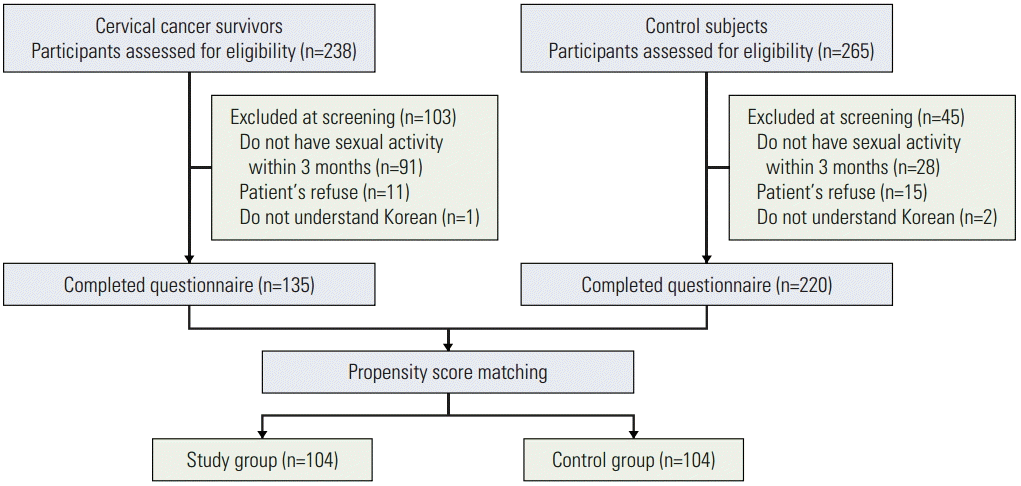Introduction
Materials and Methods
Results
Table 1.
Table 2.
Table 3.
Values are presented as mean±standard deviation. EORTC QLQ-C30, The European Organization for Research and Treatment of Cancer Quality of Life Questionnaire-Core 30; EORTC QLQ-CX24, The European Organization for Research and Treatment of Cancer Quality of Life Questionnaire-Cervical Cancer Module; FSFI, Female Sexual Function Index.
Discussion
Table 4.
| Study (year) | Study period | Inclusion criteria | Exclusion criteria | No. of participants | Age at study | FSFI total score | Years since diagnosis | Measurement | Result |
|---|---|---|---|---|---|---|---|---|---|
| Frumovitz et al. (2005) [14], USA | NA | Stage I | Combination of surgical and radiation therapies | RH (n=37) | 43.6 | 25.1 | 7.5 | FSFI, SF-12, BSI-18, menopause scale, A-DAS, CARES | Radiotherapy deteriorated sexual functioning |
| Age < 55 yr at the treatment | CCRT | Radiotherapy (n=37) | 46.9 | 17.1 | 7.0 | - | 63% of those sexually active before having cancer remained sexually active after treatment | ||
| Treatment at least 5 yr previously | Disease recurrence | Control (n=40) | 42.8 | 26.4 | - | - | Sexual functioning and QoL did not differ significantly between surgery and control | ||
| Disease-free state | Treated for other malignancies | - | - | - | - | - | - | ||
| Surgery or radiotherapy | - | - | - | - | - | - | - | ||
| Carter et al. (2008) [13], USA | Feb 2004-Jan 2008 | Stage I | NA | RT (n=30) | 18-49 | NA | NA | FSFI, FACT-CX, CES-D | At the 6-mo follow-up assessment, 70% of the women were sexually active |
| Age 18-49 yr | - | - | - | - | - | - | Postoperative dyspareunia decreased over time | ||
| Serati et al. (2009) [15], Italy | Jan 2003-Dec 2007 | Stage IB or IIA | Non-sexually active women | RH (n=38) | 47 (24-71) | 17.2 | NA | FSFI | Radical hysterectomy deteriorated sexual functioning |
| Received RH | Severe mental illness | Laparoscopy (n=20) | 45.0 (24-69) | 10.8 | - | - | Laparoscopic surgery did not show any benefit on sexuality over the abdominal surgery | ||
| - | Severe physical handicap | Laparotomy (n=18) | 44.5 (25-68) | 21.9 | - | - | - | ||
| - | Pregnant | Control (n=35) | 45 (24-69) | 30.7 | - | - | - | ||
| Carter et al. (2010) [12], USA | Feb 2004-Jan 2008 | Stage IA1-IB2 | NA | RT (n=33) | 32.6 | Baseline vs. after 2 yr 17.4 vs. 21.9 | NA | FSFI, FACT-CX, CES-D, IES | Sexual functioning and QoL did not differ significantly by surgical type |
| Age 18-45 yr | - | RH (n=19) | 37.6 | Baseline vs. after 2 yr 15.7 vs. 22.6 | - | - | - | ||
| Tsai et al. (2011) [17], Taiwan | NA | CIS or above age ≥ 20 yr | NA | CC (n=105) | 54.3 (28-78) | NA | NA | FSFI | Older age (Cl, 1.07-1.25) |
| Sexual activity 3 yr before the diagnosis | - | - | - | - | - | - | Level of education (≤ 9th grade) (CI, 1.51-10.37) | ||
| Song et al. (2012) [16], Korea | Aug 2010-Nov 2010 | Stage IA-IB1 | Refuse to participate in the survey | Conization (n=39) | 34.7 | 30.7 | 2.5 | FSFI | Radical trachelectomy and hysterectomy deteriorated sexual function than conization |
| Age < 40 yr | Laparotomic approach | RT (n=18) | 34.7 | 21.7 | 2.5 | - | - | ||
| Sexual activity preoperative | Oophorectomy with radical surgery | RH (n=24) | 36.8 | 22.4 | 2.3 | - | - | ||
| - | Adjuvant radiation and/or chemotherapy | - | - | - | - | - | - | ||
| - | Disease recurrence | - | - | - | - | - | - | ||
| Lee et al., Korea | Feb 2013-Jan 2014 | Stage I-IV | Refuse to participate in the survey | CC (n=104) | 47.0 (24-70) | 23.0 | 3.7 | FSFI, EORTC QLQ-C30, EORTC QLQ-CX24 | Body image and lymphedema were more problematic in cervical cancer survivors |
| Age ≥ 18 yr | - | Control (n=104) | 48.9 (24-66) | 21.9 | - | - | Sexual functioning was not impaired | ||
| Sexual activity within 3 mo | - | - | - | - | - | - | - | ||
| Disease-free state | - | - | - | - | - | - | - |
NA, not available; RH, radical hysterectomy; SF-12, Short Form 12; BSI, Brief Symptom Index-18; A-DAS, Abbreviated Dyadic Adjustment Scale; CARES, Cancer Rehabilitation Evaluation System; CCRT, concurrent chemoradiotherapy; QoL, quality of life; RT, radical trachelectomy; FACT, Functional Assessment of Cancer Therapy; CES-D, Center for Epidemiology Studies Depression; IES, Impact of Event Scale; CIS, carcinoma in situ; CC, cervical cancer; CI, confidence interval; EORTC QLQ-C30, The European Organization for Research and Treatment of Cancer Quality of Life Questionnaire-Core 30; EORTC QLQ-CX24, EORTC QLQ-Cervical Cancer Module.




 PDF
PDF Citation
Citation Print
Print



 XML Download
XML Download